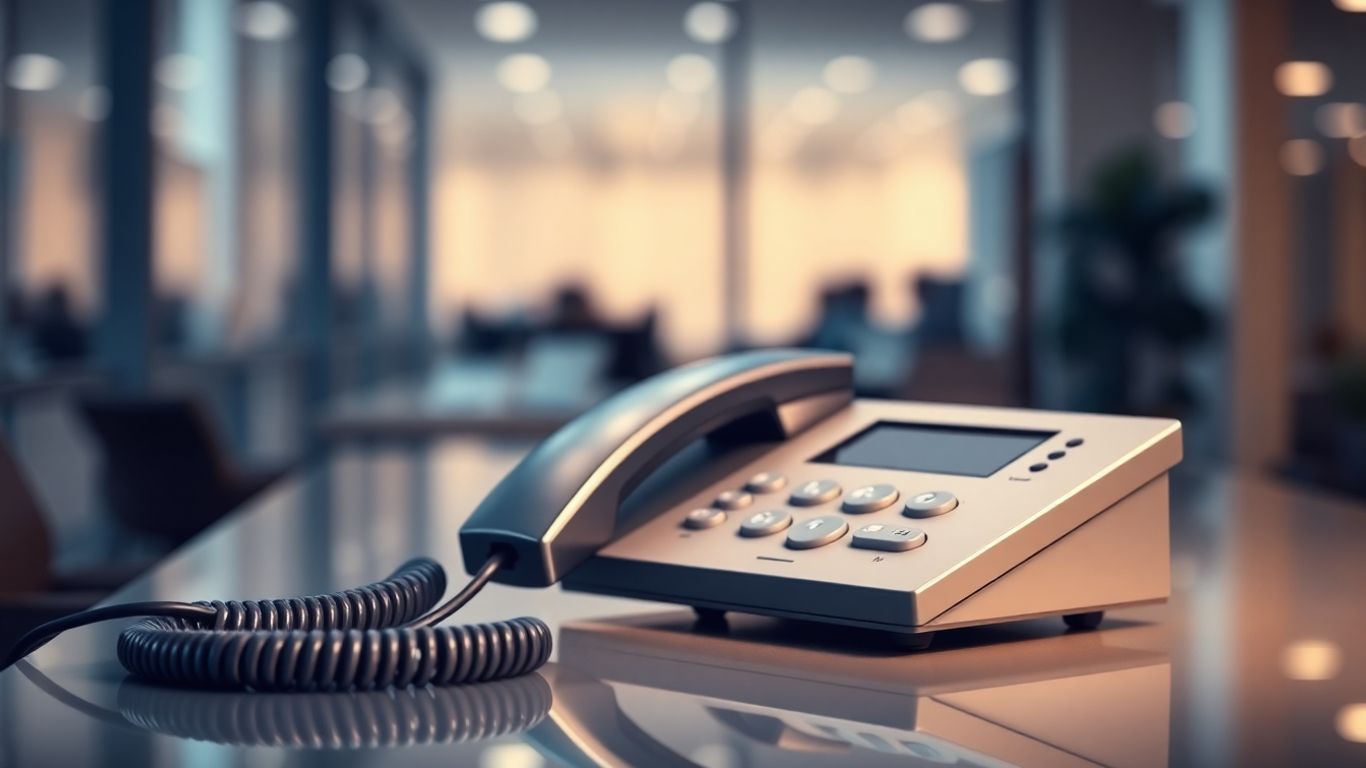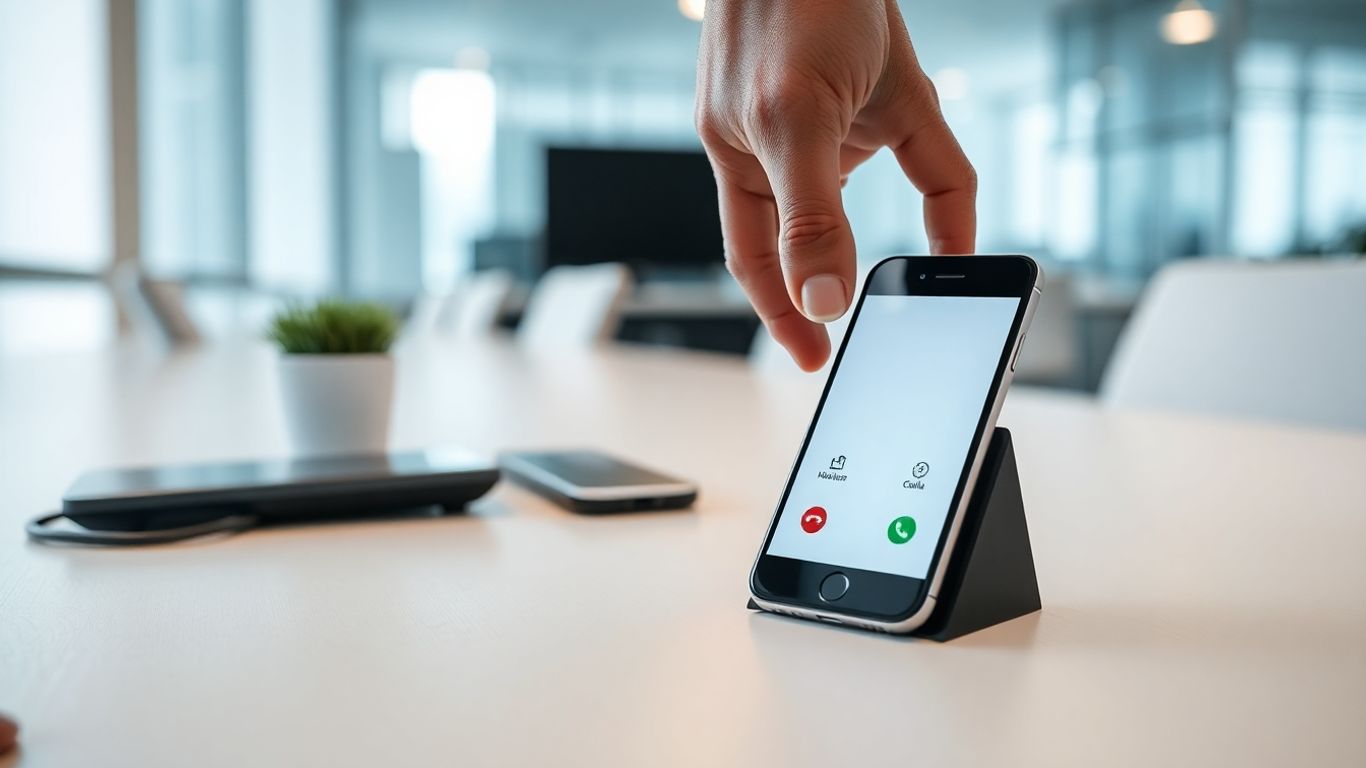Dealing with phone calls can get messy, right? Especially when your business is growing. You want customers to reach the right person fast, but sometimes it feels like a game of phone tag. That's where an auto attendant phone line comes in. Think of it as a smart helper for your phone system, making sure every caller gets where they need to go without any fuss. It’s not just about answering the phone; it’s about making that first impression count and keeping things running smoothly behind the scenes.

Think about the last time you called a business and got stuck in a phone tree that felt like a maze. You know, the one where you press '0' five times just to talk to a person? Yeah, nobody likes that. That's where an auto attendant phone line comes in. It's basically your business's digital receptionist, greeting callers and making sure they get to the right place without all the fuss.
At its core, an auto attendant is a system that answers your incoming calls and then guides the caller. It's not just a simple recording; it's an interactive system. You can set it up to offer callers a menu of options. For example, "Press 1 for Sales," "Press 2 for Support," or "Say 'Billing' to speak with our finance department." This way, calls are routed directly to the correct team or individual, cutting down on the time it takes for a caller to get the help they need. It's a smart way to manage call volume and make sure no one's waiting around unnecessarily. You can even set up advanced rules, like routing calls differently based on the time of day or if it's a holiday. This kind of setup means your business can handle more calls efficiently, which is a big deal when you're trying to grow.
First impressions matter, right? Your auto attendant greeting is often the very first interaction a customer has with your company over the phone. So, making it count is pretty important. You can record your own custom greeting, use text-to-speech, or upload pre-recorded audio files. The key is to keep it clear, concise, and professional. Include essential information like your business name and the main options available. A well-crafted greeting makes your business sound organized and customer-focused. It sets a positive tone for the entire call and can really make your brand stand out. Think of it as your digital handshake – you want it to be firm and friendly.
Sometimes, callers might not know the exact department or extension they need, or they might be looking for a specific person. That's where a dial-by-name directory comes in handy. This feature allows callers to simply type in the first few letters of a person's last name or say their name, and the system will find and connect them. It's especially useful for larger organizations with many employees. It adds another layer of convenience for your callers, making it easier for them to reach who they need without having to guess or go through multiple menus. This kind of thoughtful routing shows you've put effort into making the caller's experience smooth and efficient. It's a small detail that can make a big difference in how your business is perceived. You can find tools that help you set up these systems easily.

Think about the last time you called a business and got stuck in a maze of options, or worse, just got put on hold forever. It's not a great feeling, right? An auto attendant phone line changes that. It’s designed to get people to the right place, fast. When someone calls, they’re greeted professionally and given clear choices. This means less confusion and a lot less frustration for them. It’s about making that first contact smooth, so they feel heard and valued right from the start.
Nobody likes waiting on the phone. An auto attendant helps cut down those annoying hold times significantly. By automatically directing calls to the correct department or person, it skips the manual sorting that can slow things down. This means your customers get their questions answered or issues resolved much quicker. It’s a simple change that makes a big difference in how people feel about your business.
Here’s a quick look at how wait times can improve:
Your business doesn't stop when the clock hits 5 PM, and neither should your customer service. An auto attendant can answer calls at any hour, day or night, even on weekends and holidays. This means customers can always get basic information, leave a message, or be directed to an emergency contact whenever they need it. It makes your business seem more reliable and always accessible, which is a huge plus in today's busy world.
Having an auto attendant means your business is always 'on.' It handles initial inquiries and directs calls even when your office is closed, preventing missed opportunities and keeping customers informed. This constant availability builds trust and shows you're serious about serving them, no matter the time.
This constant availability is a game-changer. It means:
Think about how many times you've called a business and gotten bounced around, or worse, ended up on hold forever. It's a common frustration, right? An auto attendant phone line can really change that by making sure calls go where they need to, without a lot of fuss.
This is where you get to be the boss of your phone system. You can set up rules so that calls are sent to the right place automatically. For example, you can have customer service calls go to the support team during business hours, but if someone calls late at night, it could go straight to a voicemail or an on-call person. It's all about making the system work for your business, not the other way around.
Here’s a quick look at how you might set it up:
Setting up these rules means fewer dropped calls and a better experience for the person calling in. It’s about being smart with how you handle incoming communication.
Lots of calls are pretty standard. Someone needs to know your hours, or they want to leave a message for a specific person. An auto attendant can handle these common requests without needing a human to step in every single time. This frees up your staff from answering the same questions over and over.
When the phone system is doing the heavy lifting of directing calls and handling simple inquiries, your team can focus on what really matters. This could be closing a big sale, solving a complex customer problem, or working on important projects. It means your employees are spending their time on tasks that truly move the business forward, rather than just managing the phone lines.
Forget about listening to endless voicemails. Our auto attendant can take those messages and turn them straight into text. This means you can quickly scan your messages, grab the important details, and respond much faster. It’s like having a personal assistant who can read your mail for you, but for your phone calls. You get notified when a new message comes in, and it's already transcribed, ready for you to read. No more guessing what someone mumbled into their phone.
This is where things get really smart. Imagine a caller asks for pricing information. Instead of just telling them, the auto attendant can automatically send them a text message with your rate sheet right then and there, during the call. You can set up these kinds of rules for all sorts of things – sending links to product specs, special offer codes, or even booking calendar links. It makes sure the caller gets the information they need instantly, without the person on the other end having to stop and find it.
Worried about your phone lines getting jammed when things get busy? With unlimited parallel calls, that’s not a problem anymore. Your auto attendant can handle as many calls as come in, all at the same time. It doesn't matter if you have ten callers or a thousand; the system just keeps going. This means no one gets a busy signal, and every caller gets through to your automated system, no matter how hectic your business day gets. It’s a real game-changer for businesses that experience sudden spikes in call volume.
Making your auto attendant work with the tools you already use is a big deal. It's not just about answering calls; it's about making those calls do more for your business. Think of it as connecting the dots between your phone system and everything else that keeps your company running.
This is where things get really interesting. Zapier acts like a bridge, letting your auto attendant talk to thousands of other applications. This means when a call comes in, or after it ends, actions can happen automatically in other software you use. For example, a new lead from a call could automatically create a contact in your CRM, or a support request could generate a ticket in your helpdesk system. It's about making your phone line a part of your digital workflow, not just a separate communication channel.
Here's a quick look at what this connection can do:
Your auto attendant shouldn't be a standalone piece of tech. It needs to play nice with your Customer Relationship Management (CRM) software, project management tools, or any other business applications you rely on. When your phone system is linked up, it can pull up caller history when they ring, or log call details automatically. This gives your team context and saves them time digging for information.
Imagine this: a customer calls, and your auto attendant recognizes them. It can then route them to the right person or department based on their history or previous interactions. This isn't magic; it's real-time data synchronization. Your phone system is constantly talking to your other business tools, sharing information back and forth. This means:
Connecting your auto attendant to your existing tools transforms it from a simple call screener into a powerful hub for your business operations. It makes your communication smarter and your team more effective.

Keeping an eye on your phone system's expenses is pretty important, right? An auto attendant can really help with that. It's not just about having fancy call routing; it's also about making sure you're not overspending. Think of it like setting a budget for your calls. You get to decide how much you want to spend and how the system uses its features, especially if you're using AI-powered tools.
This is a big one for managing costs, especially if you're using an AI receptionist. You can actually set a limit on how many minutes the AI can be active within a certain time frame – like per day, week, or month. It's like putting a cap on how much you'll spend on that service. This way, you avoid those surprise bills that can pop up if usage goes way over what you expected. You can also set up alerts to let you know when you're getting close to your limit, giving you a heads-up to adjust things if needed. Plus, you can decide what happens when the limit is hit – maybe calls go straight to voicemail or get forwarded to a human.
Here’s a quick look at how it works:
This feature gives you direct control over your AI receptionist expenses, helping you balance service availability with your budget. It's about smart spending, not just spending less.
When you have clear limits and usage tracking, your phone bill becomes much more predictable. Instead of guessing how much you'll owe, you have a good idea based on the limits you've set and how much the AI is actually being used. This makes budgeting a whole lot easier. You can plan your expenses more accurately, which is super helpful for any business, big or small. It takes the guesswork out of your communication costs.
By setting limits and watching the usage reports, you can figure out the best times to use your AI receptionist. Maybe you need it more during busy business hours and less at night. You can adjust the limits to match these patterns. This means you're not paying for AI time when you don't really need it. It's about making sure the AI is working hard for you when it matters most, and not running up costs during slower periods. You can even use this data to see if certain times of day or week have higher call volumes, which might help you adjust staffing or other business processes too.

Your business doesn't operate 24/7, and your phone system shouldn't pretend it does. Setting specific active times for your auto attendant is key. This means your system knows when to pick up calls and when to direct them to voicemail or a specific after-hours message. It’s not just about the standard Monday-to-Friday, 9-to-5 grind, either. Think about holidays. You don't want your auto attendant wishing callers a "Happy New Year" on July 4th, do you? Setting these parameters ensures callers get the right message at the right time, which makes your business look organized and considerate. It’s about respecting your callers' time and your own team's downtime.
If your business serves customers or has team members spread across different parts of the country, or even the world, time zones become a big deal. An auto attendant can be configured to recognize these differences. For instance, a caller in California might reach a different greeting or routing option than someone calling from New York, especially if your business hours differ. This prevents confusion and makes sure callers connect with the right resources when they are actually available. It’s a simple but powerful way to make your communication feel local and relevant, no matter where the call originates. This kind of thoughtful setup really makes a difference in how people perceive your business's attention to detail.
As your company expands, your phone system needs to keep up. An auto attendant is built for this. You can easily add new departments, extensions, or even new menu options as your team grows or your services change. Need to add a "Press 5 for our new consulting division"? No problem. This flexibility means you're not stuck with an outdated system that can't handle your current needs. It grows with you, ensuring that your communication infrastructure remains efficient and effective, no matter how big you get. It’s like having a phone system that’s always ready for your next big move, without needing a complete overhaul. This adaptability is a huge plus when you're focused on expansion and don't want to be bogged down by technical limitations. You can even integrate it with other tools, like a website chatbot, to manage incoming inquiries more broadly.
Think about how much time we spend on the phone each day. For businesses, this adds up fast. We're not just talking about answering calls; it's about making sure the right calls get to the right people, quickly. Automated systems are changing this game entirely. They're moving beyond just simple greetings to actually managing conversations, pulling information from your other tools, and making sure nothing falls through the cracks. It's about making your business run smoother, day in and day out. This isn't some far-off idea; it's happening now, and it's changing how companies operate.
What really makes these automated systems shine is how they connect with everything else you use. Imagine a call ending, and automatically, your CRM gets updated. Or a customer asks for a specific document, and the system instantly texts them a link. That's the power of integration. It's not just about having a phone system; it's about having a phone system that talks to your calendar, your project management tools, and your customer database. This kind of connection means less manual work for your team and a much better experience for your customers. It's like your business is finally speaking one unified language across all its departments. For example, in the real estate industry, this means agents can get instant updates on new leads and schedule viewings without missing a beat, improving their client relationships.
So, what does this all mean for the future? It means businesses that adopt these smart, automated communication tools will have a serious edge. They'll be faster, more responsive, and more efficient. Customers will get the help they need, when they need it, without the usual frustrations. Your team will be freed up from repetitive tasks to focus on more important work. It’s about building a business that’s ready for whatever comes next. Embracing this kind of innovation isn't just about staying current; it's about setting yourself up for real growth and success in the years ahead. It's a shift from just handling calls to truly managing communication as a strategic asset.
The way businesses talk to customers is changing fast, and automation is leading the charge. Imagine your business always being available, never missing a chance to connect. This is the new reality. Ready to see how smart tools can handle your calls and chats, freeing you up to focus on what matters most? Visit our website to learn how you can get started today!
So, there you have it. An auto attendant phone line isn't just some fancy gadget for big companies. It's a practical tool that can really make a difference for businesses of any size. It helps make sure customers get to the right place without a fuss, saves your team a bunch of time, and generally makes things run smoother. Think of it as giving your business a bit of a professional polish, without breaking the bank. It’s about making communication easier for everyone involved, which, let's be honest, is pretty much the goal of any business.
Think of an auto attendant as your business's digital greeter. When someone calls, instead of a person answering, a recorded voice or an AI assistant greets them and offers options, like 'Press 1 for Sales' or 'Press 2 for Support.' It's a smart way to guide callers to the right place without needing a human to direct every single call.
It's all about saving time and effort! An auto attendant handles the simple task of directing calls, which frees up your staff to focus on more important things, like helping customers or working on big projects. It also makes sure calls get to the right person faster, so no one wastes time playing phone tag.
Absolutely! Unlike human receptionists who need breaks and sleep, an auto attendant can be set up to answer calls anytime, day or night. This means your customers can always get basic information or leave a message, even when your office is closed. It's like having a receptionist who never clocks out!
Not at all! You can record a warm, friendly greeting in your own voice or use a professional text-to-speech option. You can also create custom menus that make sense for your business. It's designed to be helpful and professional, not cold. Plus, it ensures callers get to the right department quickly, which customers usually appreciate.
No worries! The auto attendant is smart. If a caller needs to speak to a person or can't find what they need in the menu, it can easily route them to a live person, send them to voicemail, or provide alternative contact information. It's all about making sure the caller gets the help they need.
Yes, that's one of its superpowers! An auto attendant can handle many calls at the same time without getting overwhelmed. This is super helpful for businesses that get a lot of calls, especially during busy periods. It means fewer busy signals and happier callers.
By automating call routing, you might not need as many people handling phones, which saves on staffing costs. You can also set limits on how much the AI receptionist is used, helping you control expenses and avoid surprise bills. It's a cost-effective way to manage your phone system.
Definitely! Many auto attendant systems can connect with other apps you use, like your customer relationship management (CRM) software. This means when a call ends, information can be automatically updated in your CRM, or tasks can be created. It helps keep all your business information in sync and makes your whole operation run smoother.
Start your free trial for My AI Front Desk today, it takes minutes to setup!








